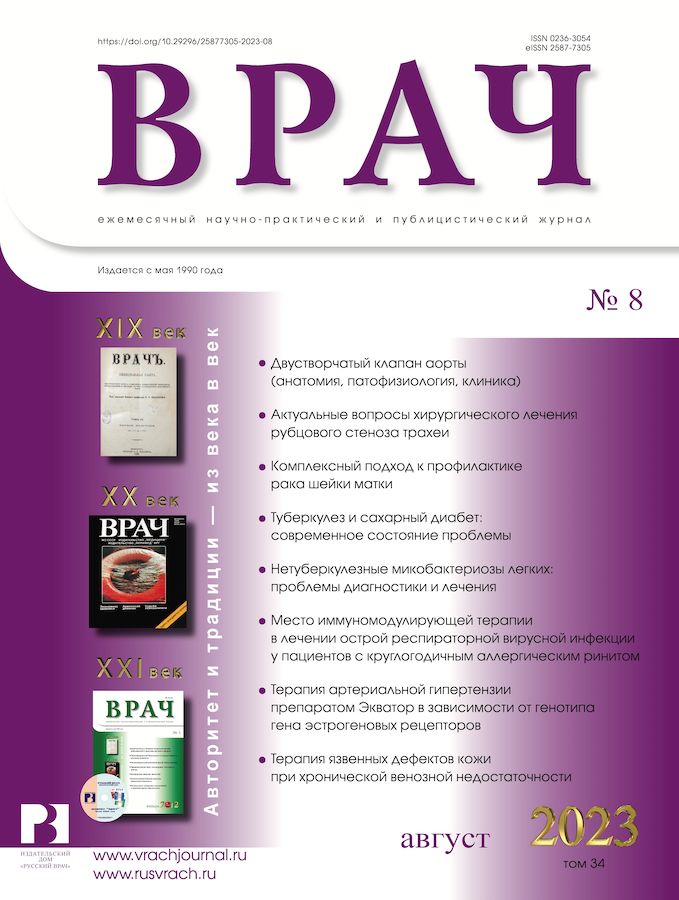Dystrophic changes of the spine in a patient with Kimmerle anomaly on the example of a clinical case
- 作者: Kutsenko V.P.1, Kovaleva D.D.1, Postanogov R.A.1, Menshikova S.V.1
-
隶属关系:
- Saint Petersburg State Pediatric Medical University
- 期: 卷 34, 编号 8 (2023)
- 页面: 63-67
- 栏目: From Practice
- URL: https://journals.eco-vector.com/0236-3054/article/view/569081
- DOI: https://doi.org/10.29296/25877305-2023-08-12
- ID: 569081
如何引用文章
详细
Of all diseases of the musculoskeletal system, degenerative changes of the spinal column occupy the first place in frequency. Especially in recent years, cases of diagnosis of dystrophic changes in the vertebrae and intervertebral discs in children have become more frequent, which indicates the rejuvenation of this pathology, and, as a result, an increase in cases of disability of the young population.
The presence of congenital defects of the vertebral apparatus is important for the rate of progression of the disease. Such an innate feature is considered to be the Kimmerle anomaly. Several variants of the Kimmerle anomaly are known: 1) ossification is observed between the articular process of the atlas (C1) and its posterior arch; 2) the bone arch connects the articular process of the Atlas and its transverse process. Pathology can be unilateral or bilateral, and the bone arch may be complete or incomplete, then the bone bridge remains unclosed in the form of an arched outgrowth.
In the presence of connective tissue dysplasia at the same time, even in the most minimal manifestations, and Kimmerle anomaly, a more rapid development of denegerative changes of the cervical spine can be observed.
全文:
作者简介
V. Kutsenko
Saint Petersburg State Pediatric Medical University
编辑信件的主要联系方式.
Email: val9126@mail.ru
ORCID iD: 0000-0001-9755-1906
Candidate of Medical Sciences
俄罗斯联邦, Saint PetersburgD. Kovaleva
Saint Petersburg State Pediatric Medical University
Email: val9126@mail.ru
ORCID iD: 0000-0002-6236-4526
俄罗斯联邦, Saint Petersburg
R. Postanogov
Saint Petersburg State Pediatric Medical University
Email: val9126@mail.ru
俄罗斯联邦, Saint Petersburg
S. Menshikova
Saint Petersburg State Pediatric Medical University
Email: val9126@mail.ru
俄罗斯联邦, Saint Petersburg
参考
- Антонов И.П., Гиткина Л.С. Вертебробазилярные инсульты. Минск, 1977 [Antonov I.P., Gitkina L.S. Vertebrobasilar strokes. Minsk, 1977 (in Russ.)].
- Барановский А.Е., Пономарев В.В., Гончарик А.С. и др. Первое успешное хирургическое лечение аномалии Киммерле в Республике Беларусь. Здравоохранение (Минск). 2018; 7: 49–54 [Baranovsky A.E., Ponomarev V.V., Goncharik A.S. et al. Uccessful surgical management of Kimmerle anomaly in the Republic of Belarus. Healthcare (Minsk). 2018; 7: 49–54 (in Russ.)].
- Барсуков С.Ф., Антонов Г.И. Аномалия Киммерле и мозговой инсульт. Воен.-мед. журн. 1992; 10: 32–6 [Barsukov S.F., Antonov G.I. Kimmerle anomaly and cerebral stroke. Military-medical Journal. 1992; 10: 32–6 (in Russ.)].
- Виндерлих М.Е., Щеколова Н.Б. Влияние диспластической нестабильности шейного отдела позвоночника на формирование нейроортопедической патологии у детей. Вестник Волгоградского государственного медицинского университета. 2022; 19 (1): 73–8 [Vinderlich M.E., Shchekolova N.B. Effect of dysplastic instability of the cervical spine on the formation of neurorthopdic pathology in children. Journal of Volgograd State Medical University. 2022; 19 (1): 73–8 (in Russ.)]. doi: 10.19163/1994-9480-2022-19-1-73-78
- Долгих Г.Б., Казакова С.А., Мубаракшина А.Р. Методы диагностики вертеброгенных головных болей у детей и подростков. Клиническая неврология. 2017; 1: 17–22 [Dolgikh G.B., Kazakova S.A., Mubarakshina A.R. Methods of diagnosis of vertebrogenic headaches in children and adolescents. Clinical neurology. 2017; 1: 17–22 (in Russ.)].
- Еренков И.О., Зорина Р.О., Воронин В.А. Диагностические аспекты рентгенологического обследования шейного отдела позвоночника у детей при головных болях. Радиология – практика. 2022; 6: 10–21 [Erenkov I.O., Zorina R.O., Voronin V.A. Diagnostic Aspects of X-ray Examination of the Cervical Spine of Children with Complaints on Headache. Radiology – Practice. 2022; 6: 10–21 (in Russ.)]. doi: 10.52560/2713-0118-2022-6-10-21
- Кириенко А.Н., Сороковиков В.А., Поздеева Н.А. Дегенеративно-дистрофические поражения шейного отдела позвоночника. Сибирский медицинский журнал (Иркутск). 2015; 7: 21–6 [Kirienko A.N., Sorokovikov V.A., Pozdeyeva N.A. Degenerative-dystrophic lesions of the cervical spine. Siberian Medical Journal (Irkutsk). 2015; 7: 21–6 (in Russ.)].
- Кулагин В.Н., Михайлюкова С.С., Лантух А.В. и др. Аномалия Киммерле: аспекты диагностики и лечения основных клинических синдромов. Тихоокеанский медицинский журнал. 2013; 4: 84–7 [Kulagin V.N., Mikhailyukova S.S., Lantukh A.V. et al. Kimmerle’s anomaly: aspects of diagnostics and treatment of main clinical syndromes. Pacific Medical Journal. 2013; 4: 84–7 (in Russ.)].
- Кулагин В.Н., Брюховецкий И.С., Гуляев С.А. Клинико-нейрофизиологические особенности патологии нервной системы у больных с синдромом Киммерле. Актуальные вопросы аллергологии, педиатрии и детской хирургии. Владивосток, 2006; с. 125–9 [Kulagin V.N., Bryukhovetsky I.S., Gulyaev S.A. Clinical neurophysiological features of pathology of the nervous system in patients with Kimmerle syndrome. Topical issues of allergology, pediatrics and pediatric surgery. Vladivostok, 2006; pp. 125–9 (in Russ.)].
- Нажмудинова О.М., Гончарова Л.А., Удочкина Л.А. и др. Современные методы лучевой и инструментальной диагностики патологии шейного отдела позвоночника у детей. Астраханский медицинский журнал. 2020; 15 (3): 23–32 [Nazhmudinova O.M., Goncharova L.A., Udochkina L.A. et al. Modern methods of radiation and instrumental diagnostics of cervical spine pathology in children. Astrakhan medical journal. 2020; 15 (3): 23–32 (in Russ.)]. doi: 10.17021/2020.15.3.23.32
- Орел А.М. Какова в действительности форма шейного отдела позвоночника у детей. Bulletin of the International Scientific Surgical Association. 2018; 7 (1): 27–9 [Orel A.M. What is the actual shape of the cervical spine in children. Bulletin of the International Scientific Surgical Association. 2018; 7 (1): 27–9 (in Russ.)].
- Терновой С.К., Серова Н.С., Беляев А.С. и др. Методика функциональной мультиспиральной компьютерной томографии в диагностике плоскостопия взрослых. REJR. 2017; 7 (1): 94–100 [Ternovoy S.K., Serova N.S., Belyaev A.S. et al. Methodology of functional multispiral computed tomography in the diagnosis of adult flatfoot. REJR. 2017; 7 (1): 94–100 (in Russ.)]. doi: 10.21569/2222-7415-2017-7-1-94-100
- Янова Э., Мардиева Г., Гиясова Н. и др. (2022). Костная перемычка первого шейного позвонка. Вестник врача. 2022; 1 (4): 93–100 [Yanova E., Mardieva G., Giyasova N. et al. Bone bridge of the first cervical vertebrum. Doctor’s Herald. 2022; 1 (4): 93–100 (in Russ.)]. doi: 10.38095/2181-466X-20211014-92-99
- Gorsha O.V., Korolenko N.V., Shkolna M.V. et al. Physical therapy of cephalgia in dysplastic instability of the cervical spine in children. World Med Biol. 2021; 17 (75): 36–41. doi: 10.26724/2079-8334-2021-1-75-36-41
补充文件










